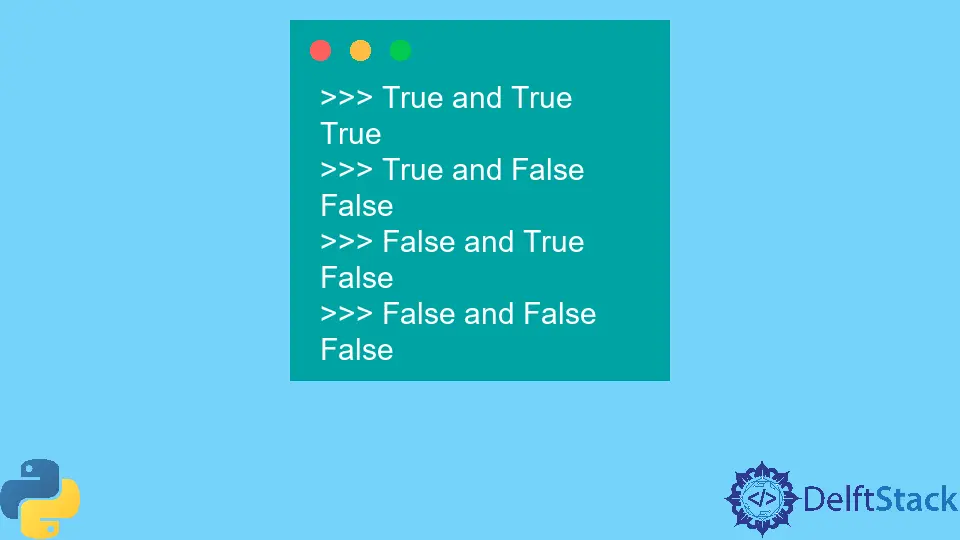The Short Circuit Evaluation in Python
- Logical Operators in Python
- What Is Short-Circuiting
-
Short-Circuiting Using
ANDOperator in Python -
Short-Circuiting Using
OROperator in Python

This article is about showing short-circuiting behavior in Python using logical operators.
Logical Operators in Python
the OR Operator
OR: Both operands are evaluated using the Python or operator. The or operator returns True if either of the operands is True.
However, the or operator will return False only if all the given expression or operands returns False.
Logic table of OR operator:
| First Value | Second Value | Output |
|---|---|---|
| True | True | True |
| True | False | True |
| False | True | True |
| False | False | False |
Representation of the above OR operator in the Python console:
>>> True or True
True
>>> True or False
True
>>> False or True
True
>>> False or False
False
Python also allows us to compare multiple expressions using the OR operator.
>>> (5 < 10) or (8 < 5)
True
>>> (5 < 10) or (8 < 5) or (2 == 2) or (9 != 8)
True
the AND Operator
AND: When using the Python and operator, both operands are evaluated, and if any given expression or operator is not true, then False is returned. The and operator only returns True when both the given expression or operands is True.
Logic table of AND operator:
| First Value | Second Value | Output |
|---|---|---|
| True | True | True |
| True | False | False |
| False | True | False |
| False | False | False |
Representation of the above AND operator in the Python console:
>>> True and True
True
>>> True and False
False
>>> False and True
False
>>> False and False
False
Comparing multiple expressions using the AND operator.
>>> (5 < 10) and (8 < 5)
False
>>> (5 < 10) and (8 < 5) and (2 == 2) and (9 != 8)
False
>>> (10 == 10) and (8 != 5) and (2 == 2) and (9 != 8)
True
What Is Short-Circuiting
Short-circuiting refers to the termination of a Boolean operation when the expression’s truth value has already been established. The Python interpreter evaluates the expression in a left-to-right fashion.
Python’s numerous Boolean operators and functions allow short-circuiting.
def exp(n):
print("Hello")
return n
To see how short-circuiting takes place, we will use the above function as one of the operands or expressions, which will print the word "Hello" when the Python interpreter executes it.
Short-Circuiting Using AND Operator in Python
Using the and operator:
>>> True and exp(1)
Hello
1
The Python interpreter evaluates the code from left to right in the above code. According to the logic table of the AND operator, the expression must be True to get a True Boolean value.
The Python interpreter evaluates our function only because the first value is set to True.
What if we set the initial value to False? Observe the below code:
>>> False and exp(1)
False
Since the initial value is set to False, the Python interpreter ignores the latter expression, saving the execution time.
Swapping the Expression:
>>> exp(1) and True
Hello
True
>>> exp(1) and False
Hello
False
In these codes, our initial expression is the function we created earlier. The Python interpreter evaluates the given function first, resulting in the output "Hello".
Note: The function we have created produces no error or
FalseBoolean value. Hence, the Python interpreter will always have to evaluate and latter expression when the former is the given function when theandoperator is used.
Short-Circuiting Using OR Operator in Python
Using the or operator:
>>> True or exp(1)
True
Evaluating the code from left to right. Setting the initial value to True allows the Python interpreter to ignore the execution of the latter expression, which is the given function.
Hence, according to the given logic table of the OR operator, the output is True.
>>> False or exp(1)
Hello
1
The Python interpreter executes the function in the above code because the former value is set to False.
Swapping the Expression:
>>> exp(1) or True
Hello
1
>>> exp(1) or False
Hello
1
When we swap the expressions, our created function is executed every time since it is the first operand that the Python interpreter evaluates.
Considering either of the above code examples, the or operator will return a True Boolean value.
However, if we get a False Boolean value using the or operator, we can tweak the created function a bit.
def exp():
print("Hello")
return False
>>> exp()
Hello
False
After the above changes, whenever we call the exp() function, it will only return the False Boolean value after printing Hello to the console.
>>> exp() or True
Hello
True
>>> exp() or False
Hello
False
Since the function only returns a False Boolean value on every call, the Python interpreter must evaluate the latter expression or operand.
